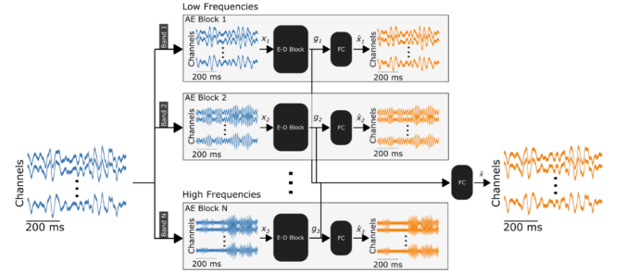The Neuroscience team works to develop and test AI algorithms for neural and behavioral data to enable new discoveries about brain function
We particularly focus on algorithms that can process, organize, and analyze large datasets in real time. These real time analyses will enable new approaches to understanding brain function through causal, closed-loop manipulations. The team includes experimentalists who generate new datasets across multiple neural measurement modalities (electrophysiology, optical imaging) working closely with computational researchers who develop new algorithms using a variety of machine learning methods. This close collaboration, and interactions with the broader A3D3 institute, allows the neuroscience team to directly test new algorithms and hardware within new experiments to validate real time capabilities.
Example Projects
Real time detection of neural states from high-density electrophysiology measurements to drive closed-loop manipulations
Simultaneous recordings from many neurons have come to suggest that population-level features may better capture computations in the brain, but tools to detect and compute these features in real time for closed loop experiments are limited. This project aims to use auto-encoder algorithms that learn relevant latent features from high-density electrophysiology measurements made with devices like Neuropixels Probes in real time. These methods will be used to enable new experiments where behavioral information or neural stimulation are controlled by detected neural population patterns to better understand how population features contribute to brain computations.
Real time detection of neuronal cell assemblies from large-scale calcium imaging to drive closed-loop manipulations
Optical techniques like calcium imaging make it possible to measure the activity of most of the neurons in a portion of the brain, which as revealed precisely coordinated activity among groups of neurons. Detecting these “cell assemblies” in real time will make it possible to do closed-loop manipulations to better understand how they contribute to brain computations. This project aims to use [X algorithm] to detect cell assemblies from largescale mesoscope calcium imaging in real time. These methods will be used to enable new experiments where neural stimulation is controlled by detected cell assembly activity to probe Y.
Improved AI algorithms for reconstructing and predicting neural time-series
Unsupervised and semi-supervised methods for reconstructing and predicting neural time-series have become very useful for data-driven discovery of structure within datasets. For example, auto-encoder methods can reveal latent features in neural data that better predict behavior, and can organize motion tracking measurements to find patterns or categories of behaviors. Predicting (forecasting) future neural activity will also be beneficial for real time interventions in neuroscience. This project direction aims to develop general purpose AI methods for neural data time-series with a focus on methods that may be able to generalize across different measurement types (e.g., multiple types of electrophysiology, calcium imaging) and that are computationally efficient for real time deployment and high throughput analyses.



Multi-block Recurrent Auto-Encoder (MRAE) architecture for reconstructing broadband neural data, such as micro-electrocorticography (Nolan et al., BioRxiv 2021).
